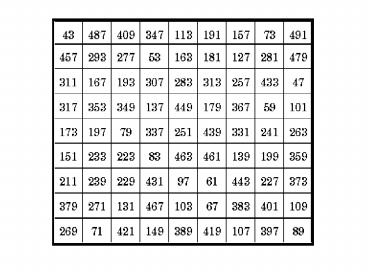Characteristics: - PowerPoint PPT Presentation
1 / 24
Title:
Characteristics:
Description:
'A whole number that can only be divided without a remainder ... Playing Badminton or tennis (2 minutes) Dribbling Basketball around the tennis court (2 minutes) ... – PowerPoint PPT presentation
Number of Views:42
Avg rating:3.0/5.0
Title: Characteristics:
1
(No Transcript)
2
- Characteristics
- Whole number
- Divisible by itself
- Divisible by one
- Definition
- A whole number that can only be divided without
a remainder by itself and one
3
Guided Inquiry
Data Collection
4
How Does Your Heart Rate? Name
__________________________ Predict your resting
heart rate I predict my resting heart rate is
________________ per minute Calculate your
resting heart rate My resting heart rate is
________________ per minute My partners resting
heart rate is ________________ per minute
5
(No Transcript)
6
Questions to answer What happened to my body,
as I became more active? ________________________
__________________________________________________
____________________ What did I observe through
the data collected? ______________________________
__________________________________________________
______________ Why did my heart rate increase
with exercise? ___________________________________
__________________________________________________
_________
7
- Guided inquiry process
- Concept exploration
- Concept elaboration
- Concept extension
- Application
- Evaluation
8
- Cooperative Teaching Methods
- Jig-saw
- Teams-Games-Tournament
- Think, Pair, Share
- Pair of Pairs
- The Doughnut (Inside-Outside Circle)
- Numbered-heads together
9
- 5 Basic Elements of Cooperative Learning
- Face-to-face interaction (oral)
- Positive interdependence
- Individual accountability
- Social skills
- Group processing (evaluation)
- PIGs .
10
(No Transcript)
11
Direct Instruction
12
- Swanson identified 12 criteria associated with
direct instruction. When any four of these
indicators are present, direct instruction is
occurring - Breaking down a task into small steps
- Administering probes
- Administering feedback repeatedly
- Providing a pictorial or diagram presentation
- Allowing independent practice and individually
paced instruction - Breaking the instruction down into simpler phases
- Instructing in a small group
- Teacher modeling a skill
- Providing set materials at a rapid pace
- Providing individual child instruction
- Teacher asking questions
- Teacher presenting the new (novel) materials
(Swanson, 2001, p. 4).
13
Highly Effective Questioning (HEQ) (vs. Socratic
questioning?)
14
Occasional, Random Questioning Vs.
Systematic, Consistent, Deliberate Questioning
15
Blooms Taxonomy Cognitive Scaffolding Lesson
Plan (objectives)
16
- HEQ gives importance to the development of
critical thinking skills (p.4) - The four elements of critical thinking skills
are - A mental act
- A critical act
- Amenable to instruction
- Generalizable across content
17
Which question is better? Why? Do you see
X? What do you see?
18
Principle 1 Students come to school with the
need to learn, and when they are in school they
do not have the right not to learn Practice Invo
luntary questioning of each and every student
19
Principle 2 Students are undertrained not
underbrained they are dormant but not
dead! Practice Try to ask each student an equal
range of questions (quantity) and, initially,
questions of similar difficulty (quality).
Remember to choose your question, then choose
your student.
20
Principle 3 We must learn to use intensive
questioning, not just occasional
questioning Practice Ask only questions during
the lesson and refrain from explaining, telling,
hinting, and other non-questioning strategies.
Question, question, question ask only questions
21
Principle 4 We must follow a question-response-qu
estion (Q-R-Q) pattern in our questioning of
students Practice Have students justify all
responses
22
Principle 5 We must not be negative when asking
students questions Practice Never ask negative
questions. Be positive or neutral
23
Principle 6 We do not ask questions that promote
random trial and error behavior Practice Do not
ask questions that encourage guess-making
24
Principle 7 We must act to discourage the use of
I dont know as a way for students to avoid
classroom participation Practice If a student
says I dont know, follow up immediately with
one to three additional questions































